Orange candleflower identification and control
Information about the noxious weed orange candleflower. Orange candleflower is also known by its Latin name, Arum italicum.
About this weed
Orange candleflower is a non-regulated Class C noxious weed. This means due to how widespread it is, property owners are not required to control this species on their property, though it is encouraged. Orange candleflower is also on the Washington state quarantine list and it is illegal to buy, sell or offer it for sale in the state.
Orange candleflower is known as Arum italicum and it is in the arum family. Other common names include Italian arum, Italian lords and ladies, Italian lily, and cuckoo’s pint.

Why it’s a problem
Orange candleflower was originally introduced as an ornamental plant from the Mediterranean region. It has naturalized in several regions in western Washington and appears to be spreading rapidly. It is designated Class C to raise awareness and promote control due to its toxicity, establishment in riparian and other habitats, and because it is very difficult to remove once it has established.
Plant description
Orange candleflower is a perennial (plants that have a life cycle of 2 or more years), herbaceous (no woody stem) plant originally from the Mediterranean region. All parts of the plant are poisonous. If eaten, it can cause swelling, burning, and severe pain in the lips, mouth, tongue, and throat. Skin contact with the sap can cause minor irritation.
Orange candleflower establishes in open woodlands and forest margins. It grows from tubers (thickened underground part of a stem that stores nutrients, i.e., potato) and produces multiple tubers during a growing season. They break off in the soil and produce new plants. It can grow to about 1.5 feet high. Orange candleflower has a unusual life cycle where it’s flowers develop before the leaves in spring, and leaves unfurl as the seed is almost ripe in autumn.
The leaves are arrow-shaped and glossy with long stalks. They can grow up to a foot long and are greyish green with pale midribs.
Their tiny white flowers, which bloom April through June, are clustered together surrounded by a large bract. The flower has an unpleasant smell. It has been described as the odor of stale urine.
After flowering, the leaves and bract will fade leaving bright orange and red berries in August and September. The berries form in tight clusters. In the autumn, new leaves will emerge and stay evergreen throughout the winter in warmer climates. In cooler climates, they die back and regrow in the spring.






Be aware of look-alike plants
More information about plants orange candleflower is often confused with:
When in doubt, take photos and report them on iNaturalist.
What to do if you find it
Because orange candleflower is so widespread, property owners in King County are not required to control it. However, the King County Noxious Weed Control Board does encourage property owners to remove orange candleflower where possible, and to avoid introducing it to new landscapes.
Even though we are not generally tracking infestations we can provide advice on how to control orange candleflower.
Control methods
We recommend using a combination of methods to control noxious weeds. In areas with few weeds, it is important to act quickly before they become harder to control. Make a long-term plan as it often takes several years to get rid of most weeds. Start in the least infested areas first and then move into more heavily infested areas.
Orange candleflower is very difficult to remove once it has established. Early control is especially important. Repeated follow up is recommended. Wear gloves and other protective clothing to avoid skin contact as plant parts may cause skin irritation. This can be especially severe in sensitive individuals.
At a minimum, cut and bag the fruit in August before it scatters its seeds.
Manual control
Careful digging around the stem, all the way down to the tuber, removing the tuber (thickened underground part of a stem that stores nutrients, i.e., potato) and all parts of the plant. Sifting the soil can help remove all the little bits. Try not to disturb neighboring plants, which may be competing for resources, as much as possible. Cut and bag the stems with berries to prevent seeds from being spread.
Chemical control
Stay safe when using herbicide:
- Always read the label before use.
- Wear a long-sleeved shirt, long pants, shoes, and eye protection.
- Follow state and local regulations.
See the PNW Pest Management Handbook for the most up to date and specific method for chemical control of orange candleflower.
For more information or a site-specific recommendation in King County, contact us or your local weed board.
Disposal instructions
Do not move soil with orange candleflower to new locations or compost piles as the tubers may spread and start new infestations. Dispose of the tubers and seeds in a sealed bag in the garbage.
Noxious Weed Disposal - Washington State Noxious Weed Control Board

 Translate
Translate